The absolute number one fault is for a photo to be blurred. Simple out of focus error has lost me more otherwise well composed shots than I've had hot dinners.
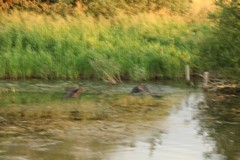
Camera moving and shutter speed too slow
So what's the cure?
It depends on what caused it. If the camera was moving or shaking in your hand then you need to stabilise the camera in future. It will also help to use higher shutter speed if possible to compensate for movement of the subject.
Stabilization can be done by resting the camera, or your elbow, on a solid surface ie. car, tree, friend's head etc. The more zoom you are using the more this becomes imperative. A long zoom will amplify any camera shake.
Even better is a tripod, but it's bulky and if you are walking it's another fairly heavy piece of kit to add to whatever else you are carrying so you may not want to take one with you. A compromise here is a Monopod. It'll give you quite a lot of stability without all the weight of a tripod.
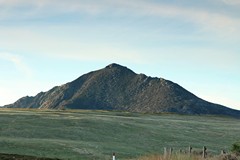
Camera on tripod allows slow shutter 1/15s
in evening light. Where there is no discernible
movement this is ok
Another point is - always buy a lens with image stabilisation (vibration reduction) on it. And make sure it's switched On whenever the camera is being hand held. Yes, I've fallen for that one too. However when using a tripod it is suggested that image stabilization is switched Off as it can allegedly cause a decrease in sharpeneing in this situation.
Other tips related to tripod use are to use manual focus in conjunction with a method of remote release to prevent vibration caused by you pressing the shutter release button, and using mirror lock up as a further means of reducing camera motion.
To get the sharpest images in any method of shooting it is best to find the lens 'sweet spot' which is the aperture at which the lens produces its sharpest images. It's usually in the mid range from around f/5.6 to f/8 and the way to find it is by trial and error using a target stuck on a wall. Take photos at incremental apertures and eyeball the results.
With a nice steady camera you can get away with some fairly slow shutter speeds hand held providing the subject isn't moving. The exact
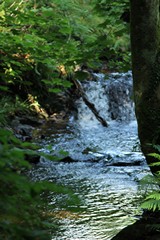
Nicely focused on the ferns
in the RH bottom corner
instead of the waterfall. The
camera decided that the I
should be focused on the nearest
object and as iwas using multiple
focus points, it selected the
focus point on the ferns to use.
numbers here will depend on the lens but I'd say around 1/15th second for a landscape with a lens of less than 50mm in goodish light should be possible. Obviously only go as slow as you have to. If you are not in critical need of front to back depth of field then open up the aperture as much as you can. This will help with the vibration reduction by allowing a faster shutter speed, but will make no difference to the actual focus as the lens on a DSLR opens up to its maximum when focusing, then snaps to the desired aperture as you press the shutter release.
What if the camera was nice and steady but instead of a good sharp photo of a waterfall it has somehow insisted on focusing beautifully on a branch 6ft in front of the lens and left your composition a fuzzy mess?
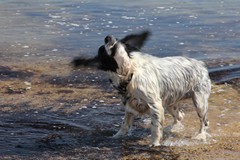
Focus would have been ok but the shutter
speed of 1/125s is too slow for this action
shot. This is motion blur caused by the
subject and the only way to compensate for
it is with a faster shutter speed
Well you could move to a better location with nothing to interrupt the view, but maybe it's not possible so you have to do something about it. The best thing I've found is to use Spot (or single point) focus instead of the default setting, which tends to pick any one of the 65 or however many focus points on your camera that the camera feels like, and mess up a lot of good shots.
Set the camera to use the centre focus point only. This is often more sensitive than the others anyway as it is usually a cross type sensor, or in some cameras which have multiple cross type sensors it is a dual cross type sensor. A cross-type sensor is a horizontal line sensor and a vertical line sensor at the same AF point, meaning that point is able to detect lines in both orientations - that makes it more likely that the AF point will be sampling a feature that has the correct orientation to activate the sensor.
In a dual cross type sensor there are another two sensors on the diagonals making it even better at acquiring focus lock. Make sure that the centre point is bang on the subject before pressing the shutter.
If you don't know how to set the focus point then you'll have to bite the bullet and RTFM. I know manuals are horrendous but it's got to be done. You have to know your equipment to get the best out of it, and you may not have time to consult in the field.
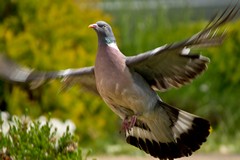
Focused on the eye but the shutter is slow
enough to show some wing movement, as was
my creative intent. Had the eye been fuzzy
as well, the image would have been thrown out
As an alternative here I use the following highly recommended method.
Back Button Focus decouples the shutter button and autofocus system and allows you to take photos without the camera changing the focus. The focus system is programmed onto a separate button to the shutter button and so taking a picture becomes a two button process.
An advantage of this is that once focus is set on (usually) the AF-ON button or whichever button I choose, after I've pressed that button the focus won't change until I press the designated button again even if I move the lens about and take several pictures.
If you want to focus and recompose your image it won't attempt to refocus if you have released pressure on the shutter button. The shutter button simply takes the photo and has nothing to do with focus. Your camera won't try to focus on a leaf or other obstruction beween you and the subject if you have recomposed your shot or the subject, or you, have moved slightly. Either they'll all be focused or all be destined for the bin. Manual focus will achieve similar results but with wildlife photography you hardly ever have time to do this.
It sounds a bit ponderous but if you try it for a while I'd be surprised if you reverted to the default method of focus being on the shutter release button.
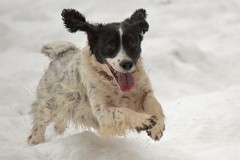
Lovely! Her head is in focus and no blurring
due to a 1/1600s shutter speed
So now we have eliminated camera shake and got the subject in focus but the animal is running or bouncing around like Tigger, and any image will still be fuzzy due to motion blur. Assuming you don't want this effect as a feature of your photo then the answer is to up the shutter speed. For my dog photo I'd be thinking 1/500 second at least and if we are out in the sun maybe as much as 1/2000th if I can get away with it. You might have to boost the ISO of the camera a bit to achieve this, as well a opening up the aperture, if the light isn't really bright. Boosting the ISO increases the sensitivity of the camera's sensor to light, but can decrease the picture quality. It's a trade off between blur and picture quality but I don't think it's really noticeable at ISOs of less than about 800 unless you are planning on having giant wall posters made up.
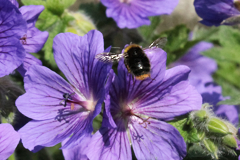
Here I've got good light so I was able to
increase the shutter speed to 1/4000s
to try and stop the motion of the bee's wing.
I'd have gone higher if the camera would
allow it. I used quite a small aperture to give
a little more depth of field but the trade off
was in increased ISO
When you want to stop some fast action with a very fast shutter speed, you could put the camera into shutter priority mode which allows you to fix the shutter speed to whatever you want and the camera adjusts the aperture, and also the ISO if you have set it to auto, to get the right exposure. Without the ISO adjustment, aperture on its own may not be able to compensate for the reduction in light transmission due to a very high shutter speed.
The usual advice when trying any of this with a telephoto lens is to use a minimum shutter speed of 1 over the focal length, so for my big 400mm lens I'd like to achieve a mimimum of 1/400th of a second at full zoom. With a cropped sensor body like my 7D mk2 this needs to be multiplied by the crop factor of 1.6 and so becomes 1/640th seconds. Sometimes I just can't get this but that's what I try for. However this is offset by the fact that the lens provides up to 3 stops of image compensation so in theory it comes back down to 1/80th seconds. So in the real world get it as high as you can can if you have leeway, and if not then learn how slow a speed you can hand hold.
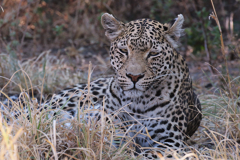
Focused on the eye and I am happy even
though the back of its body starts to blur a
little. The leopard was in shade and so the
aperture was opened to f/6.3 which shortened
the depth of field. As long as the eye is
sharp it's ok, as everyone perceives the photo
as being in focus
When taking a group of animals or people, pick one of them to focus on - don't focus between them else you'll get a lovely clear background and a fuzzy group of subjects. Also, if you don't want a 'wide open' shot with lots of bokeh then using a smaller aperture gives you a bit more leeway for slight focus errors because the depth of field will be greater.
Always try and focus on the eye of an animal; for some reason it pleases the viewers and makes the whole thing look like you knew what you were doing.
Finally - clean your lens. Don't use your shirt. It can and does scratch the coating on the lens. I know. I've done it. Get a proper cloth such as the type you wipe spectacles with. A bit of dirt on the lens can show up as a big fuzzy blob on the image.